Summary
Heste-Nettet.dk (“The Horse-Net”) is a niche sectoral platform (van Dijck et al., 2018, p. 8), created specifically to serve the online horse-riding community of Denmark (Heste-Nettet, n.d.-b). It’s an old-school web-portal, encompassing most types of social media that van Dijck lists (2013, p. 8):
- TMS (trading and marketing site): “Marked”, a highly active marketplace for horses, riding equipment, fodder, real estate and more;
- SNS (social networking site): “Ryttersnak” (“Rider-chatter”), active forums used for discussing topics both related and unrelated to horses, in conjunction with its open calendar and “lodge”, a database of profiles wherein users can write a presentation about themselves and their horse(s), upload image- and video-albums, showcase user activity, and more;
- UGC (user-generated content): “Galleri”, and the functions of the different subforums on Rytternsnak serve to “support creativity, foreground cultural activity, and promote the exchange of amateur or professional content” (van Dijck, 2013, p. 8), such as book reviews, advice, pictures and videos, anecdotes and stories, forum roleplay and more.
In addition to these three by van Dijck, it’s possible to identify another two types of social interaction sites on the website:
- News: “Nyheder” (News), the front-page of Heste-Nettet.dk as well its own section, with stories written by unpaid freelancers, who are vetted by the voluntaring editorial team. The news items are curated by 5 editors and are sorted into 33 categories and innumerable tags. All news items are related to horse care, -training and -sports, and with 58 articles published in January 2020 alone, the section is very much active;
- Wiki: “Viden” (“Knowledge”) is an expansive knowledge database, which contains both user-submitted content (links to recommended horse-related sites and book reviews with added links for either purchase or rental), a curated encyclopedia of horse races, and a curated dictionary of technical terms.
The site, created in 1997, is owned by the charity fund “Heste-Nettet Fond”, which is presided over by the sole administrator, Kim Ingstrup, the site’s original creator. The fund is financed by a mixture of banner ads, transaction fees and promoted posts on the marketplace. The moderation teams are comprised solely of volunteers, and Ingstrup himself is unpaid (Heste-Nettet, n.d.-b; Heste-Nettets Fond, 2019).
Though the site has gone through multiple design iterations, as evidenced by the Wayback Machine below, the core functionalities have remained the same throughout its 22 years in existence. Features have come and gone (such as an IRC, a guest-book, and a “junior”-section), but the ability to exchange horses and goods, chat with other horse-interested people, read the latest horse-related news, and browse the curated knowledgebase have always been present on the site.
Reflection
The creation and rise to prominence of Heste-Nettet.dk follows van Dijcks genealogy of social media (2013, pp. 10–11) closely, in that the site’s ethos has been, from the very beginning, to “be seen as online [facilitator] or [enhancer] of human networks—webs of people that promote connectedness as a social value” (van Dijck, 2013, p. 11, emphasis original). This is evidenced by the slogan of the first three iterations of the site – “a gathering place for all things horse and rider” (Internet Archive, n.d., own translation) – and later in it’s mission statement on the about-us page, “The reason behind the success of Heste-Nettet.dk is that, from the beginning, it has strived to let the users speak their mind in almost every situation … The development of spaces for companionship and collaboration, in both professional and social contexts, is therefore still our top priority” (Heste-Nettet, n.d.-b).
A central divergence from van Dijck’s genealogy, however, can be found in the shift from connectedness to connectivity (van Dijck, 2013, p. 12) that characterizes the social media giants. Heste-Nettet.dk is by no means a social media giant; even with a 35 000 unique daily visitors, it’s a very low number compared the 63% of Danes (3 668 340 individuals) who use Facebook daily (DR Audience Research Department, 2019). But even then, with 1,6 million monthly views (Heste-Nettet, n.d.-b) the site still retains a surprising prominence amongst social networking sites in Denmark, it’s relatively ancient design taken into consideration.
Navigation: Immediacy and categorization
The frontpage of Heste-Nettet.dk is a relic from the past. Modern SNSs, like Twitter and Facebook both encourage the user to join the “conversation” immediately by providing the post editor at the top of, and in direct continuation of, the timeline, thereby implicitly suggesting that the correct way of using the platform is to contribute; to share. By this token, “a platform is a mediator rather than an intermediary: it shapes the performance of social acts instead of merely facilitating them” (van Dijck, 2013, p. 29).
In contrast to this, Heste-Nettet.dk is more complicated and to use. The frontpage of Heste-Nettet.dk functions like the frontpage of a newspaper, with no ways for the user to immediately join a thread and post your thoughts or respond to listings on the marketplace. Instead, users must navigate through the site to the respective sections wherein they can contribute and join the sociality.
In addition, posting new submissions is obscured compared to the ease of the major SNSs. Whether it’s posting an ad on the marketplace, creating a new thread on the forums or uploading media to the gallery, the corresponding button is small, transparent, and not central on the page, as seen on the comparison below.
Practically speaking, this means that the likelihood of users actively engaging with the platform by sharing their thoughts, ads or images is much lower: the UI of the platform doesn’t encourage it actively, rather seemingly discouraging it. Even if the user has a desire for sharing something on the platform, the process of going through the (relatively) many steps before being given the option means that the user is forced to clarify their intent through the increasing specificity of the categories, and thereby reflect on their thoughts before finally being given the option to post them. This speaks to the platform’s purpose in opposition to that of the larger SNSs; Heste-Nettet.dk does not want an immediate and unfiltered glimpse into the mind of its user.
Content: sharing your mind vs. posting a submission
Users on Heste-Nettet.dk are not explicitly requested to share “what’s on their mind” (Facebook) or “what’s happening” (Twitter). Instead of being actively nudged by an inviting, streamlined interface that through its simplicity and interested invitation promotes sharing, the process is reversed: users must have the interest in sharing prior to using the platform. In conjunction with the above, an aspect to consider is the type of content that Heste-Nettet.dk promotes through its design. Unlike giving an unfiltered glimpse into your thoughts and sentiments – thoughts that can be correlated to your real person, and sentiments that can be measured – Heste-Nettet.dk promotes content that’s relevant, specific, original and revised.
As mentioned, the user’s journey towards sharing content starts on the frontpage, which is almost completely covered in the latest news pertaining to horses. Whether the user wants it or not, the poster-to-be is informed of the very latest news. This ensures that
- the user has some semblance of what’s going on, even if only by the heading,
- the user knows that all interaction on the site happens in the context of the current affairs and
- the user is aware that the site takes its identity seriously.
This has the consequence that all interaction on the site happens on a backdrop of the sites identity – literally, as all users have to actively navigate away from the frontpage in order to interact, as opposed to Twitter and Facebook, where interaction not only is first on the front page, but happens in a narrative timeline of events; in continuation of the debate currently going on.
Additionally, the actual posting of content on Heste-Nettet.dk invites careful consideration. As mentioned, the time it takes to reach the text editor is time spent reflecting on the relevancy and specifics of one’s post. On top of this, replying to threads on Ryttersnak happens at the bottom of each thread, meaning that users have to scroll past all prior posts, and behind a “wall” that users have to remove by clicking – the text editor is hidden from sight, making viewing the easiest and thereby (by the platform) preferred mode. Starting a thread on the forums is even more complicated, not only because the button is seemingly obscured by design, but by a verification process. After typing one’s submission, the user is given the option of “show”, not “post”, which takes the user to a preview of the post in question. Here, a message in bold asks the user to thoroughly review their post. Underneath the preview of the post, a checklist of review questions have been provided, with questions such as “Have you picked the right forum and topic for your post?” and “Does the title accurately tell what the post is about?”.
This quality control is very much revealing of the values embedded into the platform, and casts it in contrast to the larger SNSs. The platform does not wish to see what’s immediately on your mind, it wants you to contribute to an informed discussion, but only provided you have quality content to share.
User transparency
Users on Heste-Nettet.dk can chose what information they wish at their own discretion, the minimum being their self-selected username. However, in order to access certain forums, they must fill in demographic information, which they must show publicly when posting – such as age when entering the “youth” forum.
An interesting facet of this is the default username that new users are given upon registration. In the registration formula, one cannot type a custom username, instead the only choice available is to fill in one’s first and last names. The username arising from this is “<First name> <initial>” (e.g. ‘Adrian S’). If a user wants to input their own username, they need to navigate to the profile settings after they have signed up. Following the logic of van Dijck (2013), the decision to make the default the persons real name the publicly available one – rather than immediately allowing users to pick their own pseudonym – is a strategy employed by the site owners in the war with the users over ‘information control’ (van Dijck, 2013, p. 53). As she points out, “platform owners have a vested interest in complete openness on the side of users; the more they know about users, the more information they can share with third parties” (van Dijck, 2013, p. 47). It’s important to note, however, that van Dijck is speaking about major SNSs. Heste-Nettet.dk does not appear to be interested in the same level of datafication (van Dijck et al., 2018, p. 33) that sites such as Facebook and Google do, given the size of the userbase and the non-profit organization behind the site.
If not for commodification (van Dijck et al., 2018, p. 37), why then would the site wish to promote user transparency? As we’ve seen thus far, Heste-Nettet.dk seemingly aims for quality over quantity in it’s content. With the default being real names, the site encourages honesty in (self)-presentation. This plays together with the “lodge” section of the site; the database of user profiles, wherein users are encouraged to share details about themselves (though explicitly NOT details that can lead to the user’s address being revealed) and their horses.
Another interesting facet to consider here is that in order to access the live chat, users must display their gender (male or female) and year of birth. While the latter is explicated in the rules of the site to be to deter paedophiles, the former is left unexplained. Turning to Rheingold (1993) might offer an alternative explanation: namely that
[t]he possibility of an electronic impostor invading people’s most intimate lives is inherent in the technology … the population of online gender-switchers numbers in the hundreds of thousands. A very few can carry their deceptions far enough to turn an entire virtual community inside out. (1993, sec. Gender)
By forcing users to reveal their gender (though the site has no means of verifying it), Heste-Nettet.dk seems to further promote openness and honesty in their userbase; to further up the quality of not only the posts on the forums, but in the interaction between individuals. Perhaps, then, Heste-Nettet.dk is evident of an “angel in the default”, rather than a devil (van Dijck, 2013, pp. 46–56).
Conclusion
An exploration of Heste-Nettet.dk is an exploration of pre-Facebook social media, of a way of interacting on the Internet before “dot.communism was replaced by dot.commercialism” (van Dijck, 2013, p. 10). The communal spirit is embedded in the site’s organization, being run by volunteers and funded by a charitable fund. Though the site employs strict rules and a purposefully unintuitive posting interface to hinder the type of content being posted on the site, it seems to nurture an online niche collectivity, fostered through the dissemination of news and useful information, promoting openness in interaction, and encouraging discussions relevant to the niche. This stands in glaring contrast to the large, modern SNSs, where connectedness has given way for connectivity and commodification (van Dijck, 2013, p. 16).
References
DR Audience Research Department. (2019). Media Development 2018. DR. https://www.dr.dk/om-dr/about-dr/media-development-2010-2018
Heste-Nettet. (n.d.-a). Heste-Nettet.dk. Heste-Nettet.dk. Retrieved February 21, 2020, from https://www.heste-nettet.dk/
Heste-Nettet. (n.d.-b). Om Heste-Nettet. Heste-Nettet.dk. Retrieved February 20, 2020, from https://www.heste-nettet.dk/omhn/index.php
Heste-Nettets Fond. (2019). Heste-Nettets Fond årsrapport: 1. Januar 2018—31. December 2018 [Annual Budget Report].
Internet Archive. (n.d.). Wayback Machine: Heste-nettet.dk. Internet Archive. Retrieved February 21, 2020, from https://web.archive.org/web/*/heste-nettet.dk
Rheingold, H. (1993). Multi-User Dungeons and Alternate Identities. In The Virtual Community: Finding Connection in a Computerized World. Addison-Wesley Longman Publishing Co., Inc.
van Dijck, J. (2013). The culture of connectivity: A critical history of social media. Oxford University Press.
van Dijck, J., Poell, T., & de Waal, M. (2018). The platform society. Oxford University Press.
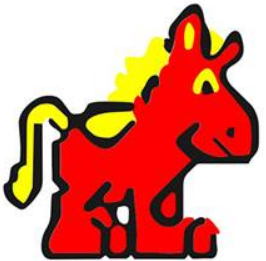


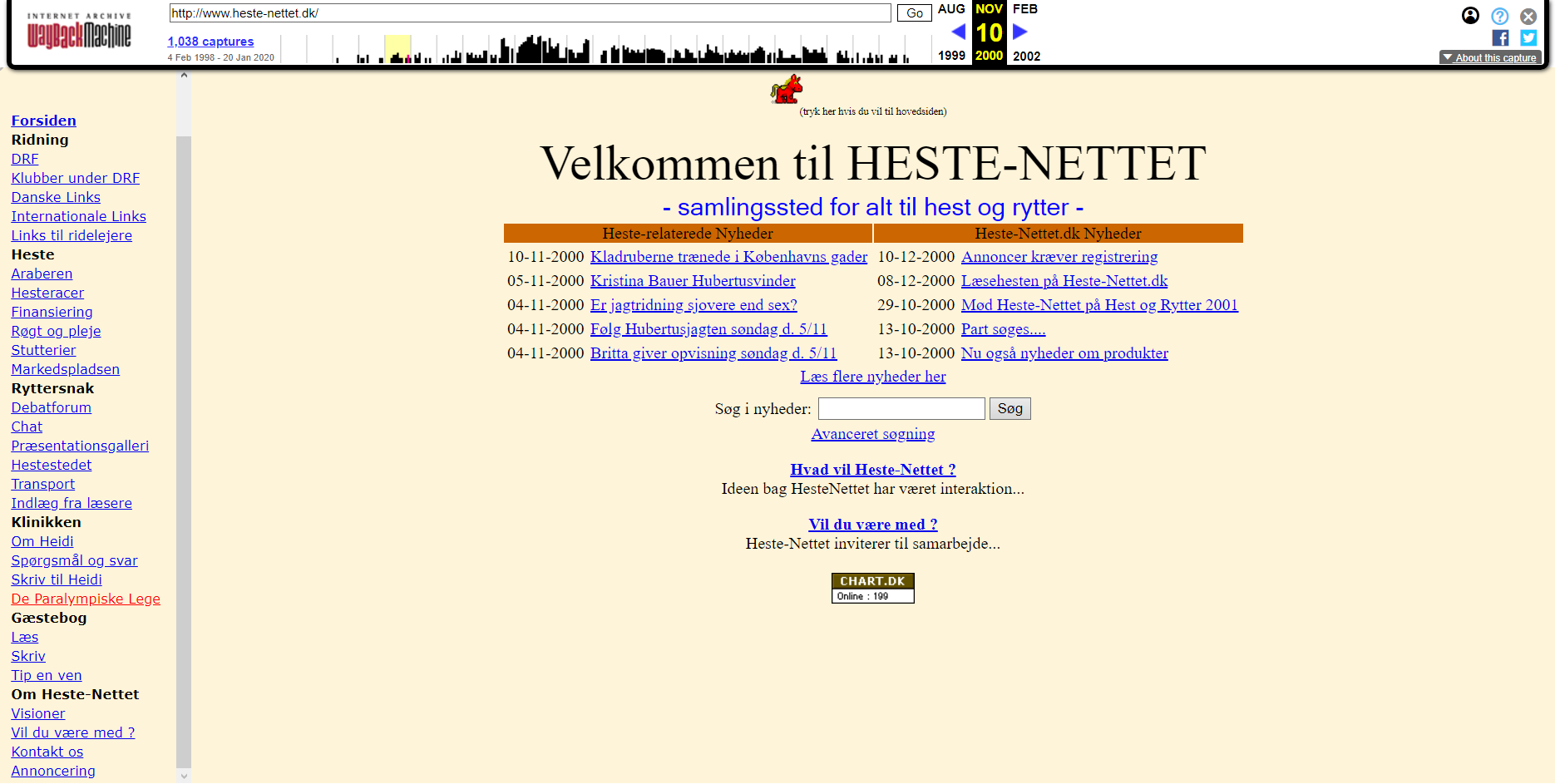
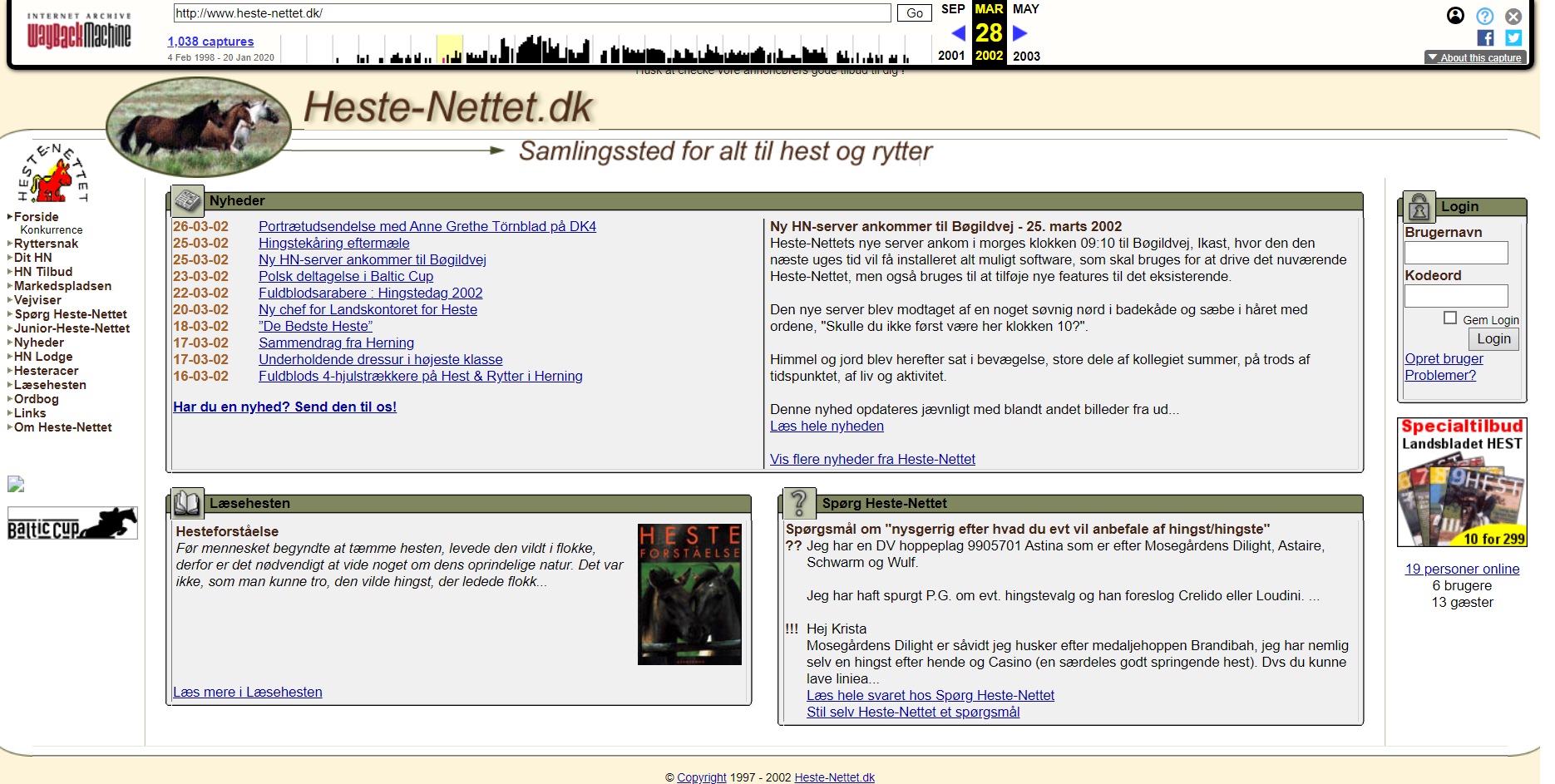
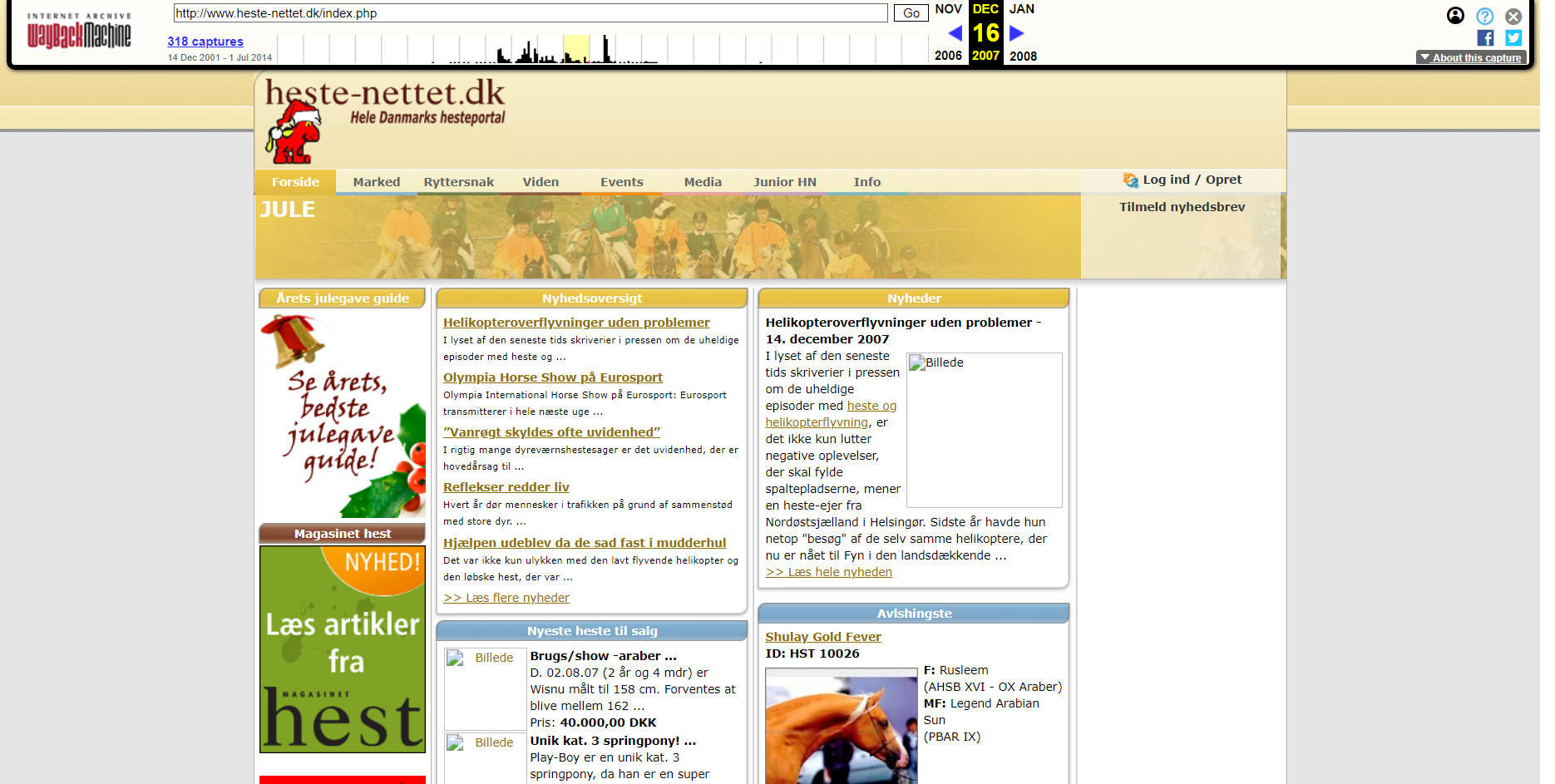
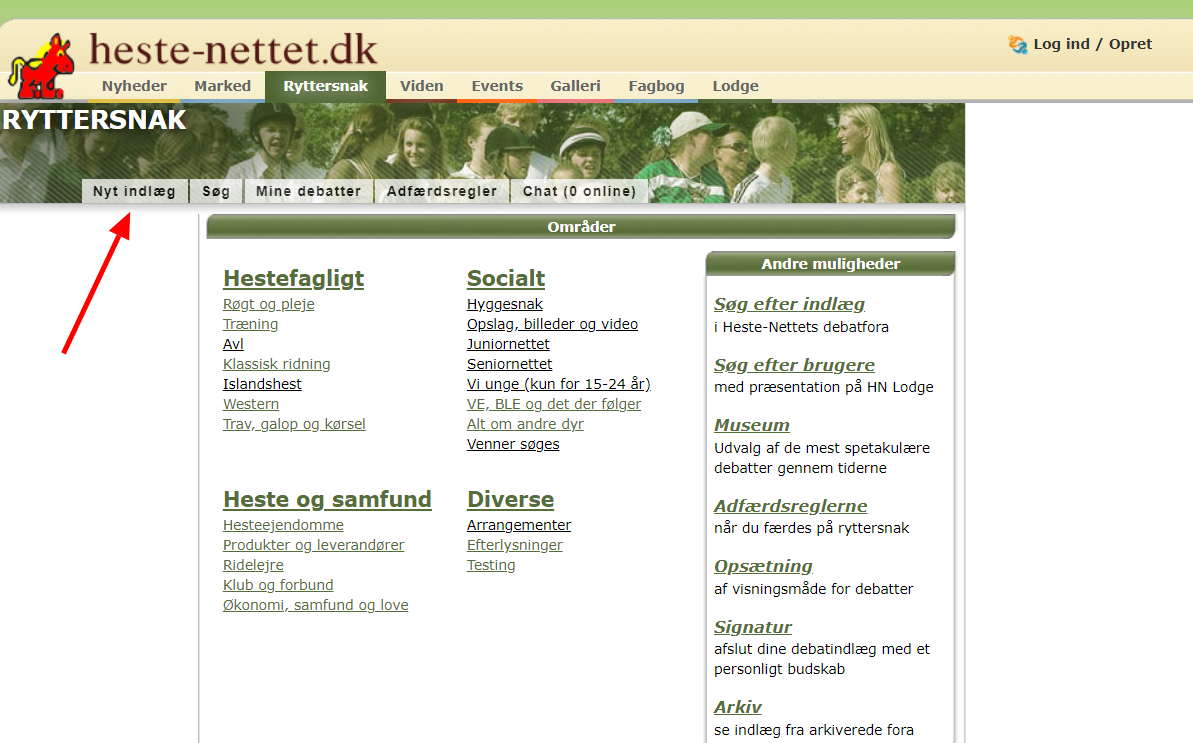

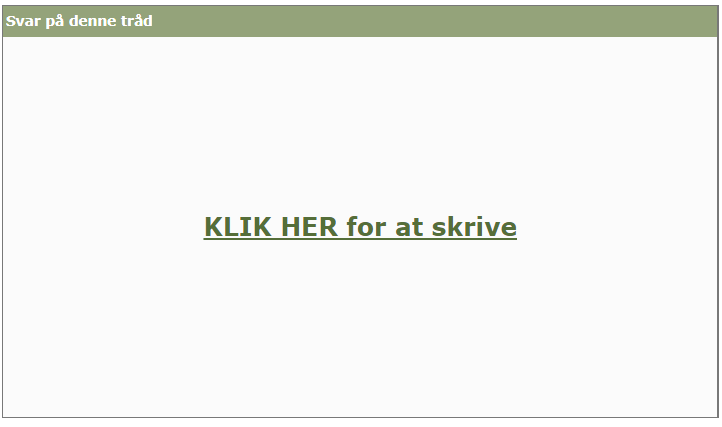

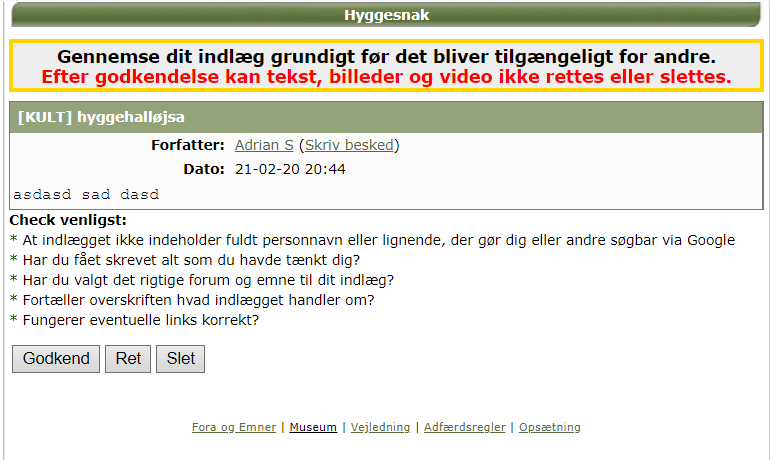
0 comments on “Heste-nettet.dk, back on greener pastures.”